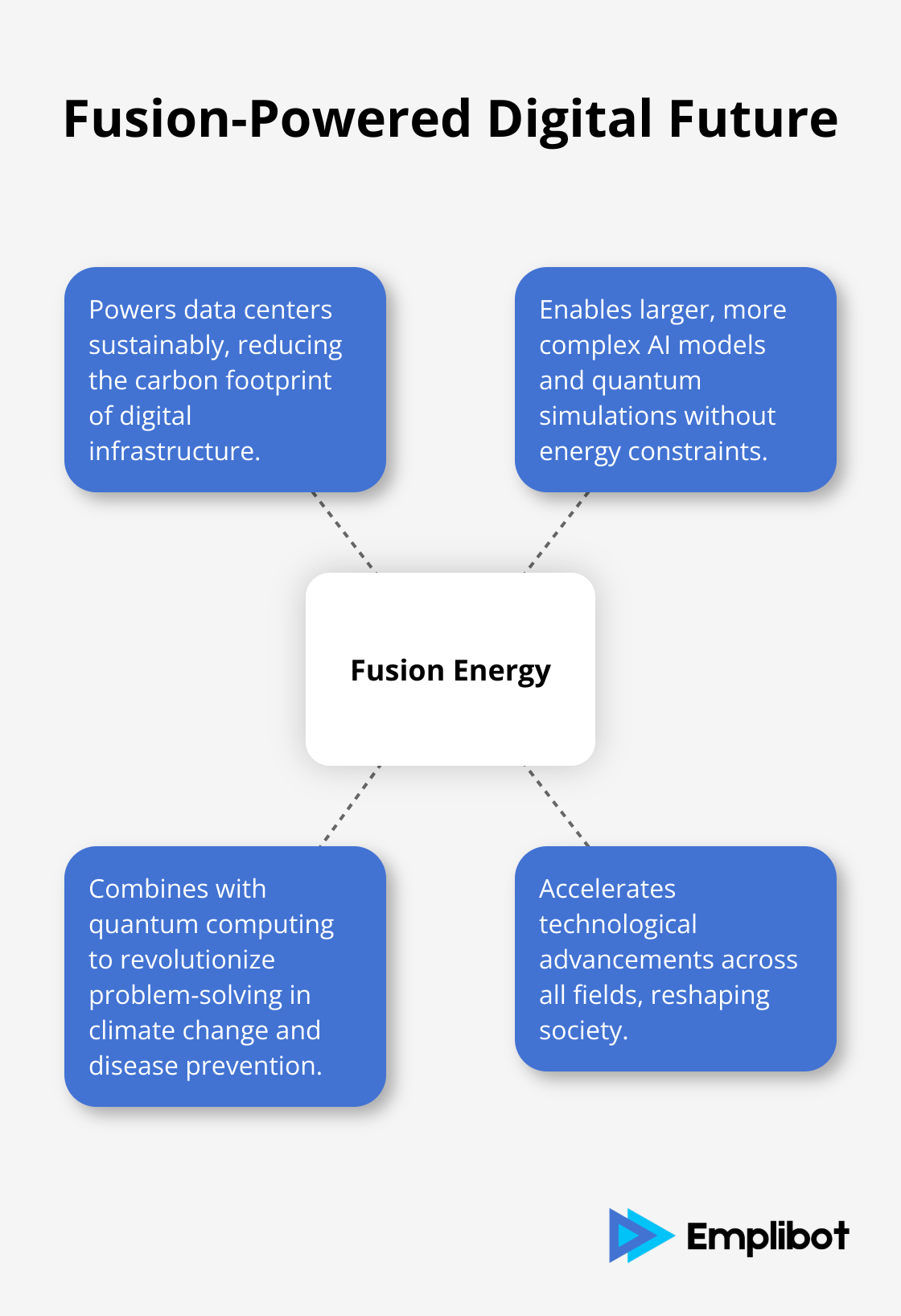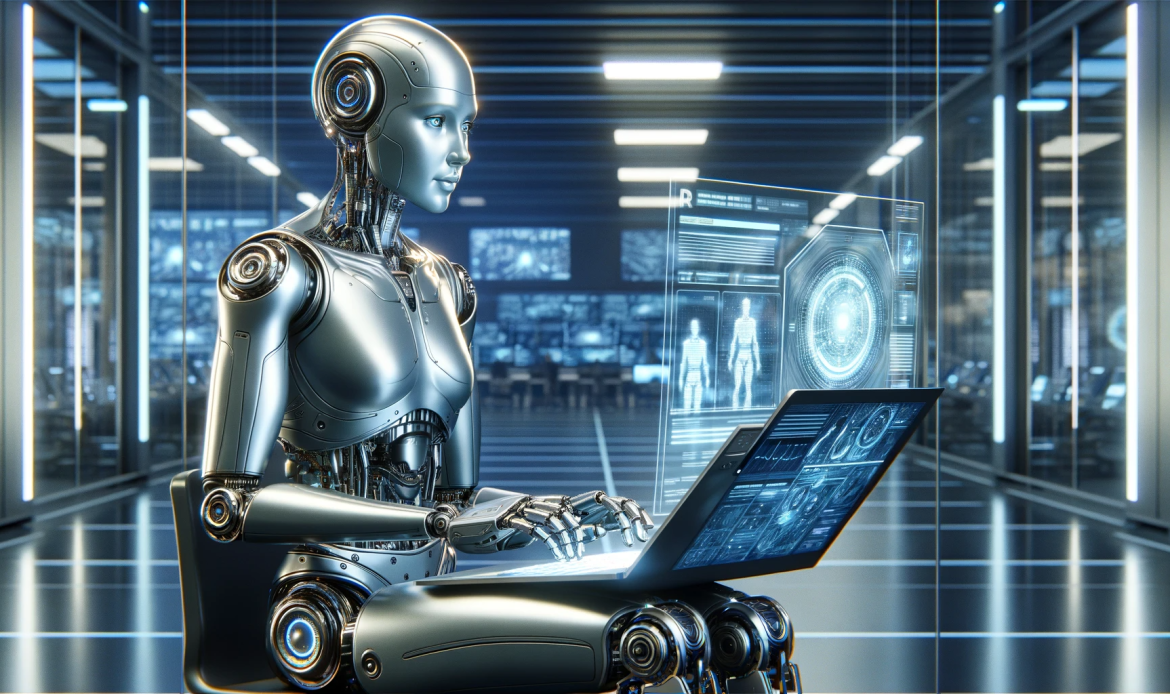At Emplibot, we’re witnessing a technological revolution that’s reshaping our world.
AI, quantum computing, and fusion reactors are converging in a perfect storm of innovation. These three groundbreaking technologies are fueling each other’s progress at an unprecedented rate.
This synergy is ushering in a new era of human advancement, promising to transform every aspect of our lives.
Contents
ToggleThe Technological Trifecta Reshaping Our World
AI’s Exponential Leap
AI has made staggering progress in recent years. A report by Stanford University shows that as of 2021, 9 out of 10 state-of-the-art AI systems are trained with extra data, implicitly favoring private sector development. This trend in AI capabilities continues unabated.

We now see AI systems that generate human-like text, create art, and even code complex software.
Quantum Computing’s Quantum Leap
Quantum computing has escaped the confines of research labs. IBM’s 127-qubit processor, unveiled in 2021, marked a significant milestone in this field. Google’s claim of quantum supremacy in 2019 (where their quantum computer performed a calculation in 200 seconds that would take a classical supercomputer 10,000 years) hints at the revolutionary potential of this technology.
Fusion Reactors: From Science Fiction to Reality
Fusion reactor technology, once relegated to the realm of science fiction, now makes tangible progress. In February 2024, the Joint European Torus (JET) facility in the UK beat its own record from 2021, producing 59 megajoules of sustained fusion energy in 5 seconds. This breakthrough brings us closer to harnessing the power of the stars here on Earth.

The Synergistic Effect
The true excitement lies in how these technologies fuel each other’s progress. AI optimizes the design of fusion reactors and quantum circuits. Quantum computing enhances AI’s capabilities by solving complex optimization problems. Fusion reactors promise to provide the enormous amounts of clean energy needed to power next-generation AI and quantum systems.
The Human Factor
As these technologies evolve and intersect, we enter a new epoch of human progress. The challenges are significant, but the potential rewards are immeasurable. We don’t just witness history – we actively shape the future of our species.
This technological convergence doesn’t just change our tools; it transforms how we work and create. AI-powered tools (like those offered by Emplibot) already enhance human productivity in tangible ways, automating routine tasks and freeing up human creativity for higher-level thinking. As we move forward, the synergy between AI, quantum computing, and fusion energy will unlock even more possibilities for human ingenuity and problem-solving.
How AI and Quantum Computing Revolutionize Fusion Research
The synergy between AI, quantum computing, and fusion research reshapes the landscape of clean energy development. This technological convergence accelerates progress in ways previously thought impossible.
Quantum Algorithms: Optimizing Reactor Design
Quantum algorithms transform fusion reactor design. This paper introduces quantum algorithms, such as Quantum Phase Estimation for predictions of energy states and Variational Quantum Eigensolver for modeling. These advancements allow scientists to explore countless design variations, potentially reducing the development timeline for commercial fusion reactors.
AI-Powered Plasma Simulations: Controlling Fusion Reactions
AI revolutionizes our understanding of plasma behavior in fusion reactors. At the Princeton Plasma Physics Laboratory, machine learning models now predict plasma disruptions with high accuracy, giving operators crucial seconds to respond and prevent damage. These AI-driven simulations run on supercomputers, processing vast amounts of data to refine our control over the fusion process.
Machine Learning: Enhancing Experimental Efficiency
Machine learning algorithms dramatically improve the efficiency of fusion experiments. At the DIII-D National Fusion Facility, AI systems now control plasma shape and stability in real-time, resulting in increased plasma confinement time. This enhanced control translates to longer fusion reactions and higher energy yields, bringing us closer to the breakeven point where fusion generates more energy than it consumes.
The Human Factor: AI-Assisted Research
While AI and quantum computing drive significant advancements, human expertise remains essential. Researchers use AI-powered tools to analyze vast datasets, identify patterns, and generate hypotheses at unprecedented speeds. This human-AI collaboration accelerates the pace of discovery and innovation in fusion research.
The fusion research landscape evolves rapidly, driven by these technological advancements. As we harness the combined power of AI and quantum computing, we redefine the boundaries of what’s possible in clean energy production. The race to commercial fusion power heats up, and the winners will likely be those who best leverage these cutting-edge tools. But as we push the boundaries of technology, we must also consider the immense energy requirements of these advanced systems. This leads us to our next topic: how fusion reactors themselves could power the AI and quantum revolution.
How Fusion Will Power Our Digital Future
Revolutionizing Data Centers
Data centers form the backbone of our digital world. In 2022, these facilities consumed about 1% of global electricity (International Energy Agency). Fusion reactors promise to provide clean, abundant energy to power these centers sustainably. This shift will reduce the carbon footprint of our digital infrastructure and enable the expansion of computational capabilities without energy or environmental constraints.
Unleashing AI and Quantum Computations
Advanced AI systems and quantum computers demand staggering amounts of energy. Training a large model across 1,000 A100 GPUs could consume up to 400 kilowatts per hour. Fusion energy will remove these limitations, allowing for larger, more complex AI models and quantum simulations. This advancement will accelerate breakthroughs in fields like drug discovery, climate modeling, and materials science.

Fusion-Powered Quantum Computers: A New Frontier
The combination of fusion energy and quantum computing represents an exciting frontier. These systems will merge the immense processing power of quantum computing with the virtually limitless clean energy of fusion. While still theoretical, such a combination could revolutionize our approach to solving some of humanity’s most pressing challenges (from climate change to disease prevention).
Overcoming Technical Hurdles
The path to fusion-powered computing faces significant obstacles. Both fusion technology and quantum computing need to overcome technical challenges. However, the potential benefits are too significant to ignore. As we continue to push the boundaries of these technologies, we reshape not just our energy landscape, but the future of computation itself.
The Role of AI in Fusion-Powered Computing
AI will play a critical role in managing and optimizing fusion-powered computing systems. Advanced algorithms will control plasma behavior in fusion reactors, manage energy distribution to data centers, and optimize the performance of quantum computers. This synergy between AI and fusion-powered computing will create a self-reinforcing cycle of technological advancement. The fusion of technology and human creativity will be essential in harnessing the full potential of these groundbreaking developments.
Final Thoughts
AI, quantum computing, and fusion reactors stand at the forefront of a technological revolution. These innovations fuel each other’s progress, accelerating advancements across all fields and reshaping our world in unprecedented ways. The impact of this technological trifecta will transform society, potentially solving complex problems in climate change, disease prevention, and space exploration.
As we embrace these transformative technologies, we must address challenges such as data privacy, algorithmic bias, and potential technological unemployment. We need to adapt our educational systems, regulatory frameworks, and societal structures to keep pace with rapid technological change. The future holds immense possibilities, from AI-optimized fusion reactor designs to quantum computers running complex AI models that accelerate scientific discovery.
At Emplibot, we harness the power of AI to revolutionize content marketing and business growth. Our automated content creation platform demonstrates how AI enhances human productivity and creativity. We must approach these advancements with excitement and responsibility, striving to implement technologies that benefit all of humanity.




![Will AI Kill Blogging? [What You Need To Do Today]](https://wp.emplibot.com/wp-content/uploads/emplibot/ai-kills-blogging-1751008068-768x456.jpeg)





